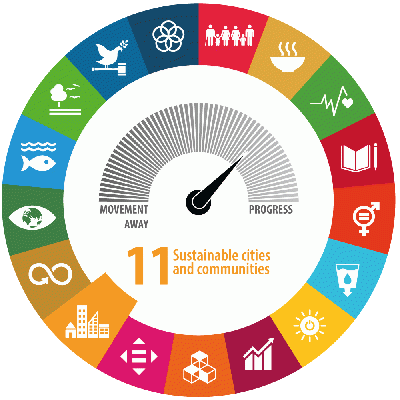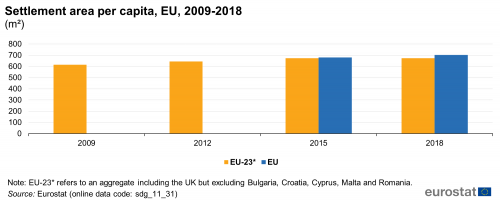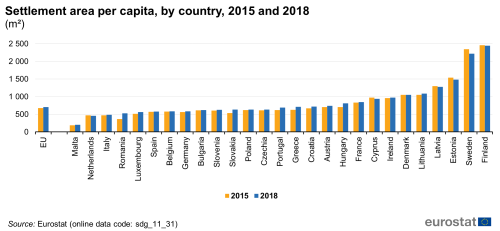Archive:SDG 11 - Sustainable cities and communities (statistical annex)
Make cities and human settlements inclusive, safe, resilient and sustainable (statistical annex)
Data extracted in May 2020.
Planned article update: June 2021.
Highlights
This article provides an overview of statistical data on SDG 11 ‘Sustainable cities and communities’ in the European Union (EU). It is based on the set of EU SDG indicators for monitoring of progress towards the UN Sustainable Development Goals (SDGs) in an EU context.
This article is part of a set of statistical articles, which are based on the Eurostat publication ’Sustainable development in the European Union — Monitoring report - 2020 edition’. This report is the fourth edition of Eurostat’s series of monitoring reports on sustainable development, which provide a quantitative assessment of progress of the EU towards the SDGs in an EU context.
Full article
Overcrowding rate
This indicator measures the share of people living in overcrowded conditions in the EU. A person is considered to be living in an overcrowded household if the house does not have at least one room for the entire household as well as a room for a couple, for each single person above 18, for a pair of teenagers (12 to 17 years of age) of the same sex, for each teenager of different sex and for a pair of children (under 12 years of age). The data stem from the EU Statistics on Income and Living Conditions (EU-SILC).

Source: Eurostat (sdg_11_10)
Population living in households suffering from noise
This indicator measures the proportion of the population who declare they are affected either by noise from neighbours or from the street. Because the assessment of noise pollution is subjective, an increase in the value of the indicator may not necessarily indicate a similar increase in noise pollution levels, but could also mean a decrease in the levels that European citizens are willing to tolerate and vice versa. The data stem from the EU Statistics on Income and Living Conditions (EU-SILC).

Source: Eurostat (sdg_11_20)

Source: Eurostat (sdg_11_20)

Source: Eurostat (sdg_11_20)
Exposure to air pollution by particulate matter
The indicator measures the population weighted annual mean concentration of particulate matter at urban background stations in agglomerations. Fine and coarse particulates (PM10) are less than 10 micrometres in diameter and can be carried deep into the lungs, where they can cause inflammation and exacerbate the condition of people suffering from heart and lung diseases. Fine particulates (PM2.5) are less than 2.5 micrometres in diameter and are therefore a subset of the PM10 particles. Their negative health impacts are more serious than PM10 because they can be drawn further into the lungs and may be more toxic. Based on the annual submission of Member States’ measured concentrations, the data are processed by the European Environment Agency (EEA), assisted by the European Topic Centre on Air Pollution, Transport, Noise and Industrial Pollution (ETC/ATNI) (and its predecessor ETC/ACM).

Source: EEA (sdg_11_50)

Source: EEA (sdg_11_50)

Source: EEA (sdg_11_50)
People killed in road accidents
This indicator measures the number of fatalities caused by road accidents, including drivers and passengers of motorised vehicles and pedal cycles, as well as pedestrians. People who die from injuries up to 30 days after being involved in a road accident are counted as road-accident fatalities. After these 30 days, a different cause of death can be declared. For Member States not using this definition, corrective factors have been applied. The data come from the CARE database managed by DG Mobility and Transport (DG MOVE).

Source: European Commission services (sdg_11_40)

Source: European Commission services (sdg_11_40)

Source: European Commission services (sdg_11_40)
Settlement area per capita
This indicator captures the amount of settlement area due to land-take, such as for buildings, industrial and commercial areas, infrastructure and sports grounds, and includes both sealed and non-sealed surfaces. This indicator is closely linked to the concept of settlement land use, which comprises physical components of shelter and infrastructure and services to which the physical elements provide support (such as education, health, culture, welfare, recreation and nutrition).

Source: European Commission services (sdg_11_31)
Recycling rate of municipal waste
This indicator measures the amount of recycled municipal waste divided by the total municipal waste. Recycling includes material recycling, composting and anaerobic digestion. Municipal waste consists mostly of waste generated by households, but may also include similar wastes generated by small businesses and public institutions and collected by the municipality. This latter part of municipal waste may vary from municipality to municipality and from country to country, depending on the local waste-management system. For areas not covered by a municipal waste collection scheme, the amount of waste generated is estimated. Member States report the amount of waste recycled and the total municipal waste generated each year to Eurostat.

Source: Eurostat (sdg_11_60)

Source: European Commission services (sdg_11_60)

Source: Eurostat (sdg_11_60)
Direct access to
More detailed information on EU SDG indicators for monitoring of progress towards the UN Sustainable Development Goals (SDGs), such as indicator relevance, definitions, methodological notes, background and potential linkages, can be found in the introduction of the publication ’Sustainable development in the European Union — Monitoring report - 2020 edition’.












